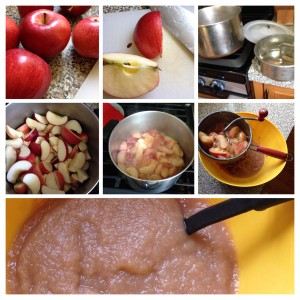Making Applesauce
I made applesauce today. It was technically my third batch of the year—though the second was scarcely worth mentioning. I’d gotten a few apples from the store that were mealy, and rather than suffer through them in apple form, I cooked them down one morning for breakfast. They were delicious once you changed their texture.
Making applesauce is a bit of a family tradition. I haven’t a clue how many years we’ve been doing it, but almost each autumn, some conglomeration of my mom, my sisters, other extended family and friends, and I have had an applesauce day. This year, Dad stepped up to the plate and he and mom handled it alone—as neither of my sisters or I were nearby, scattered about the world as we are.
I’ve thought of making applesauce other falls, and once or twice I’ve run a few apples through the mill, but a busy life and a kitchen with very little counter space conspired against taking on a big batch. But now I’m in a new place, a new job, a new house, and all of them have a bit more space in them for things like applesauce-making.
So I tackled the task this evening, definitely on a smaller scale than the family applesauce day, but enough for eating, for freezing, for giving away. And with each step, moments of applesauce days past moved into the present.
I wash the apples, only two bags of them, thinking of the year after Grandpa Warnemuende died and Grandma was selling the house with its apple trees in the yard. We went out with the apple picker and got as many Jonathans as we could, deeply dark red. It was our last chance to enjoy the bounty of those trees. And enjoy it we did–all 100+ quarts of it. The sauce that year was almost the color of raspberries, bag upon bag of fuschia-infused flavor filled our freezer for the winter.
I chop them up, using a butcher knife and only worrying about removing stems. The seeds won’t make it through the mill and will be tossed with the skins. While I’m at it I think of using Mom’s ulu knife to chop the other year, getting the hang of the rounded blade, the rhythm of the twisting wrist, the beat of the blade against board. I wondered if any Native Alaskan had ever thought of using the traditional blade for chopping fruit, and then I wondered when the remote villagers first saw apples, and when they spread their palates beyond the native blueberries and lingonberries that grow on their hillsides.
I toss them into the pot with water and turn on the flame, letting the heat and moisture do its work. On applesauce day at Mom’s, we only rested during the first pot’s cooking—for there was always more than one pot, and when you finished milling the contents of one, another was ready. But during the first pot’s cooking, if all the knives were in others’ hands, I could sometimes get a moment away to join my niece Keren, laying on the floor playing with the rattles and toys hanging from her playmat’s arches. I’d hold my hand above her face, catch her attention, and she’d reach up with her tiny gnarled hands and grasp my fingers, pulling my hand down into a hug.
I transfer them from pot to Foley mill, grateful I found it at an antique flea market in Lititz a few years back, walking through with my nephew Zach. He was intrigued by the device I picked up, this metal contraption with a red wooden handle. I showed him how you could use it, told him you put the apples in the bowl and then turned the handle to squish them against the mesh bottom. The pulp would go through, I explained, and the skins would stay in the bowl. And when the mesh got covered with skin, I told him, moving the handle in the opposite direction, you just turned the blade backward to scrape them up again.
And bowl by bowl I empty the pot of apple chunks, put them through the mill, and add to the memories categorized under “applesauce” in my mind.
1 thought on “Making Applesauce”
Comments are closed.


I was bummed when my Foley rusted in my tropical Philippine life. Good idea to keep my eye open at Lancaster Co. flea markets. Brand new ones are expensive. Generations of my family used Foleys for making applesauce. We didn’t worry about cutting out the core. Yep, Jonathans and/or Winesaps for a rich red color.